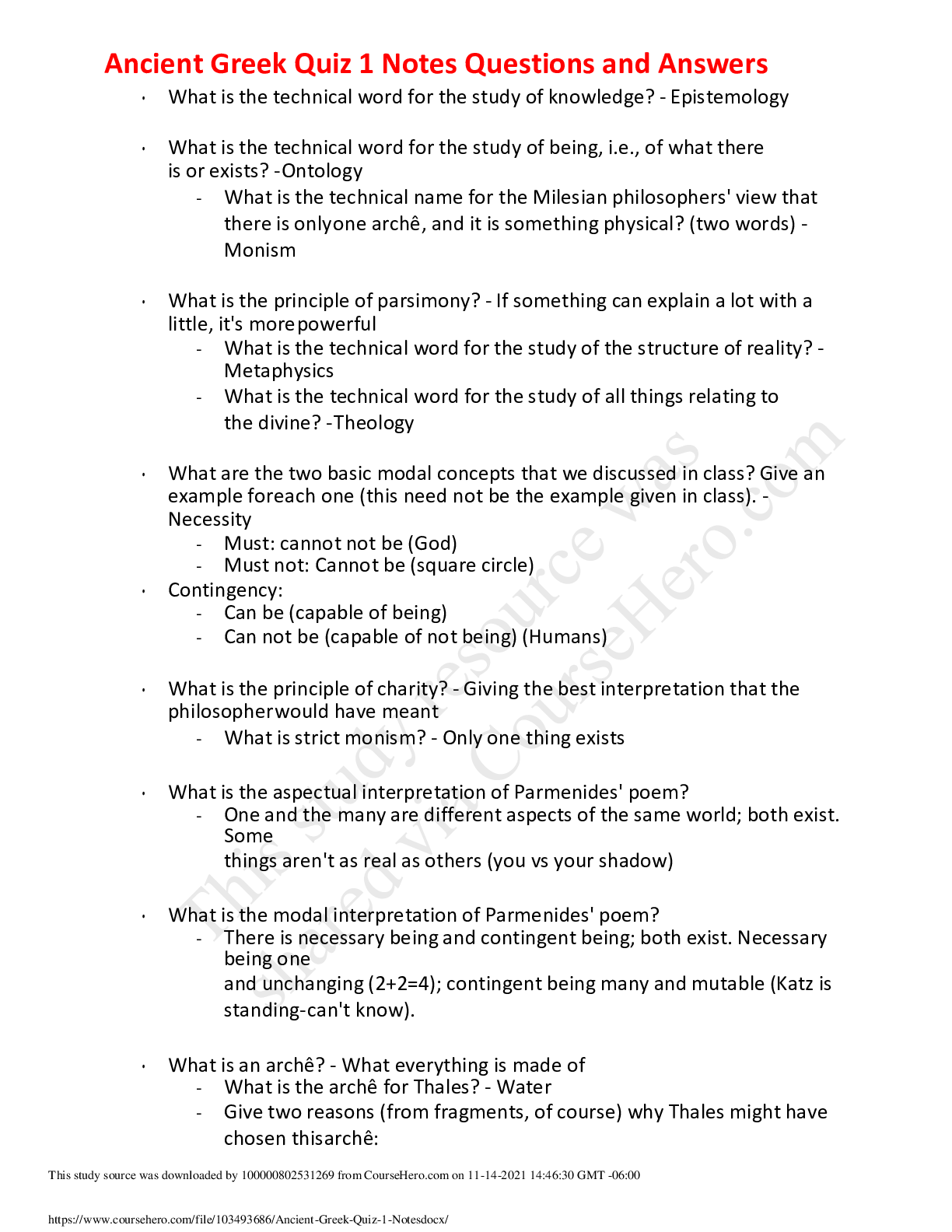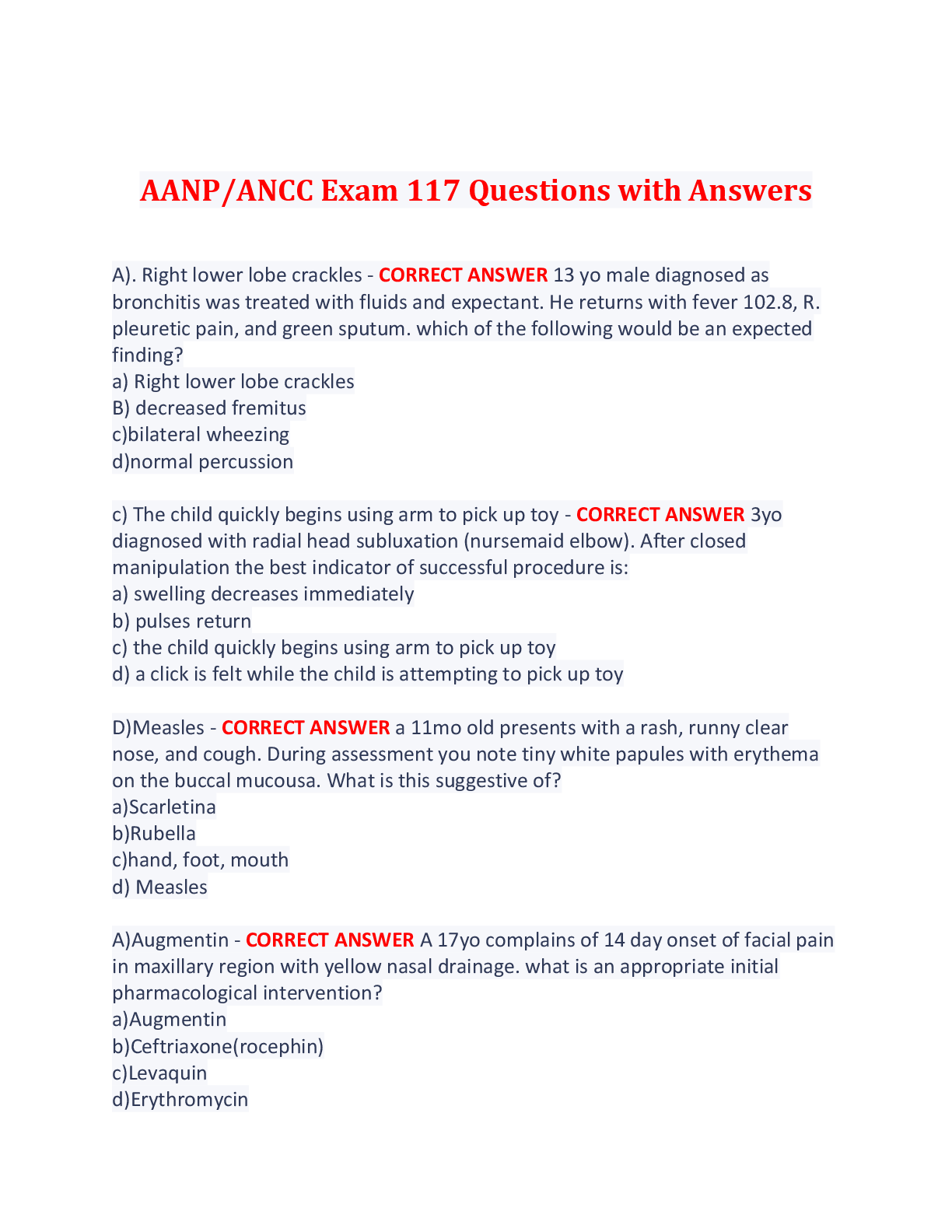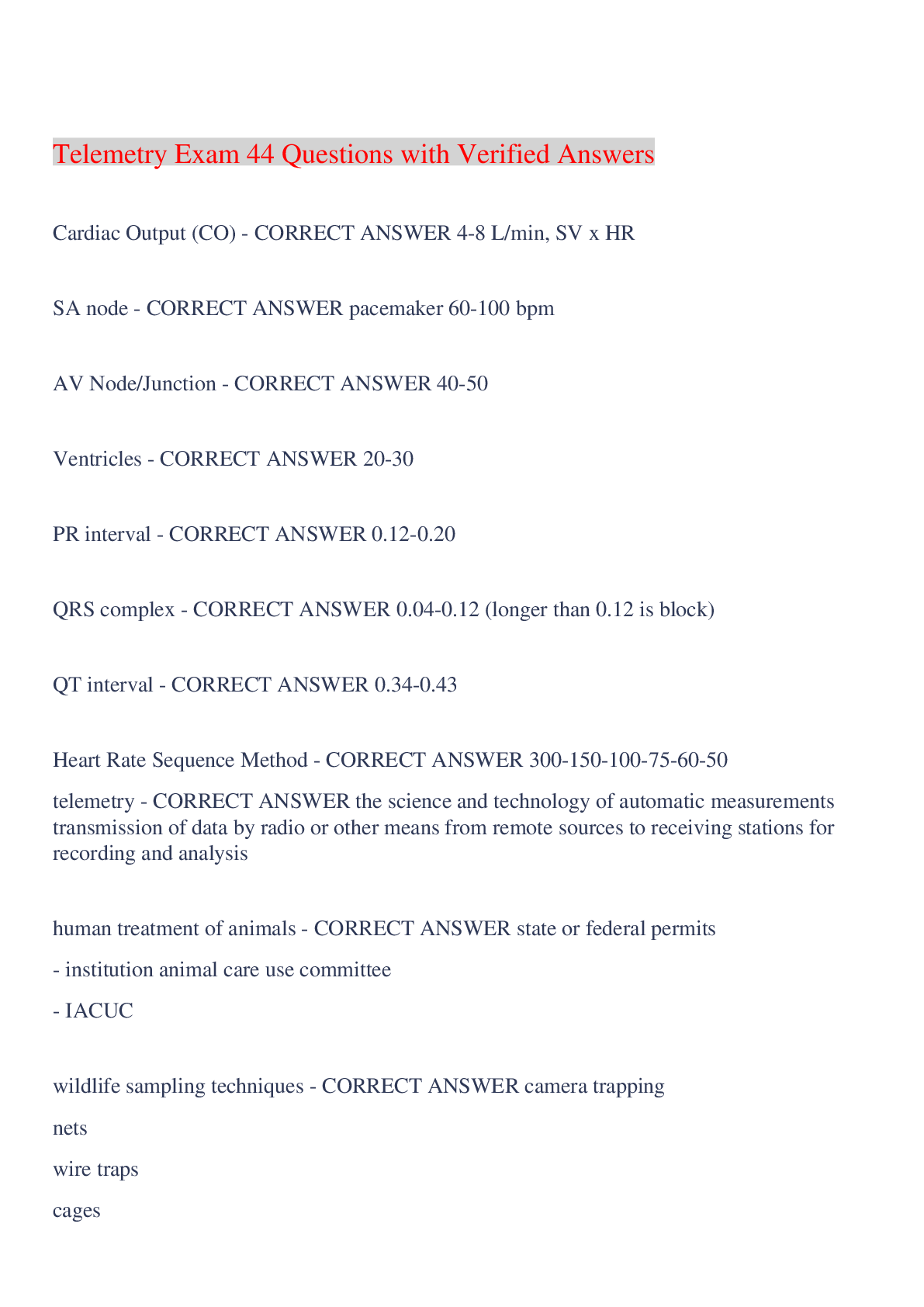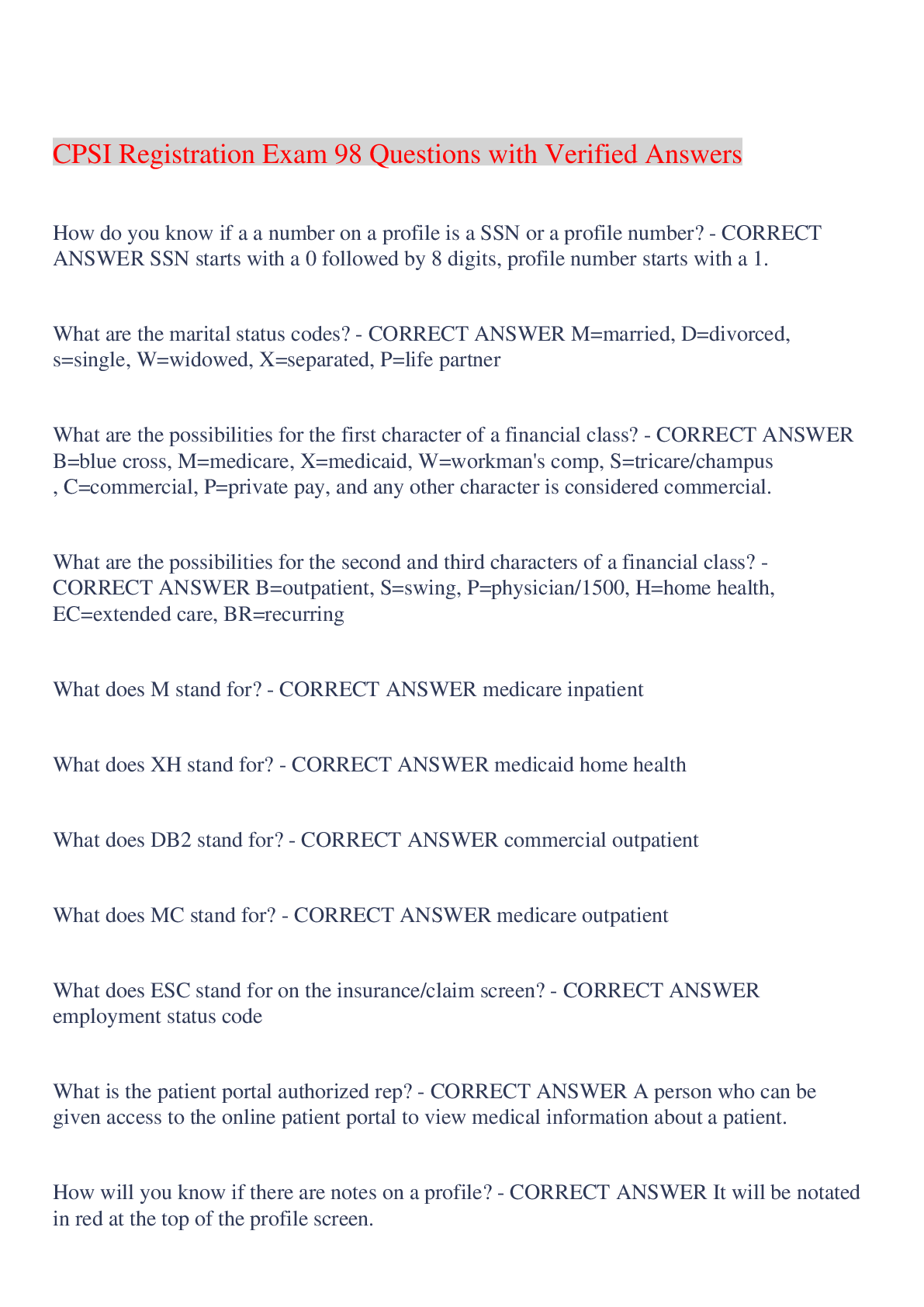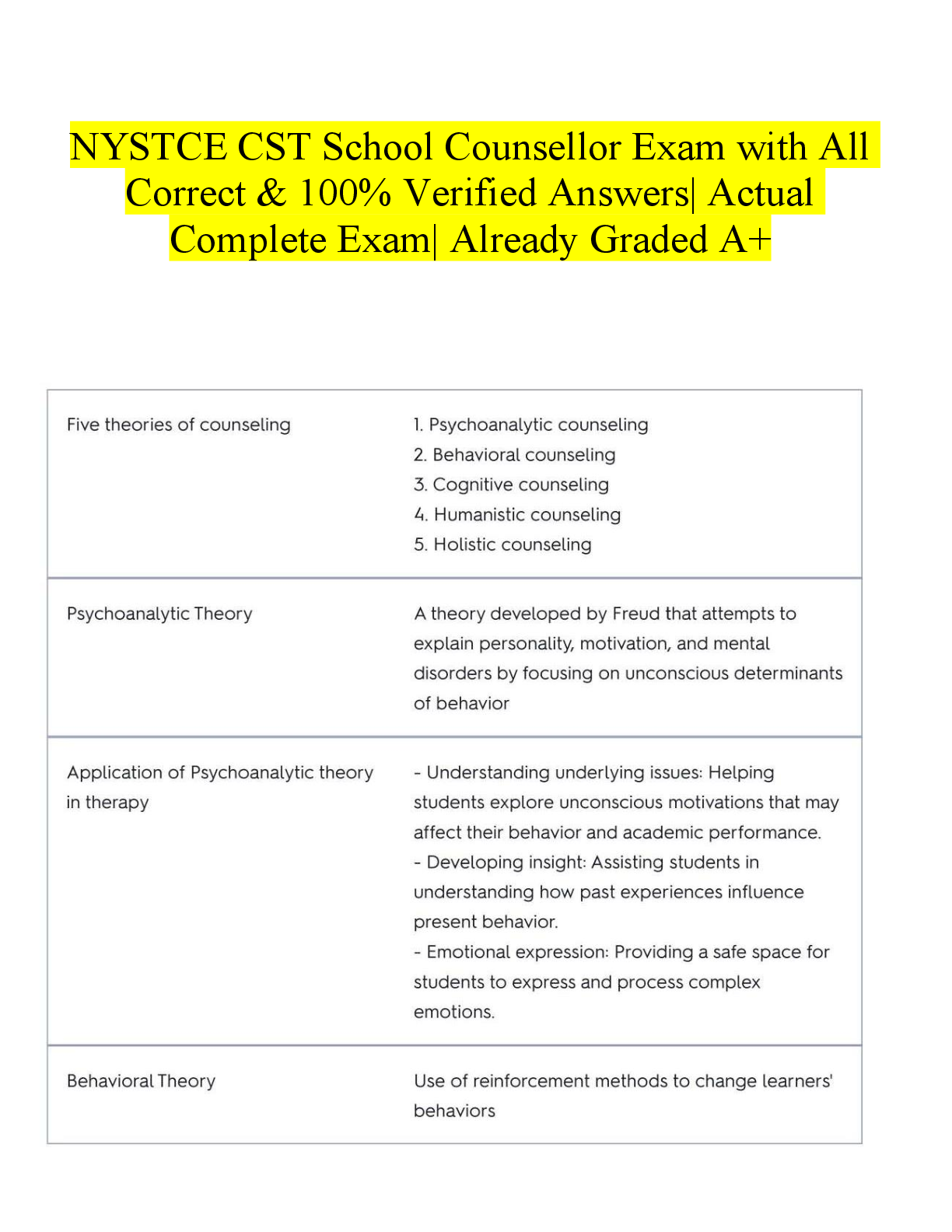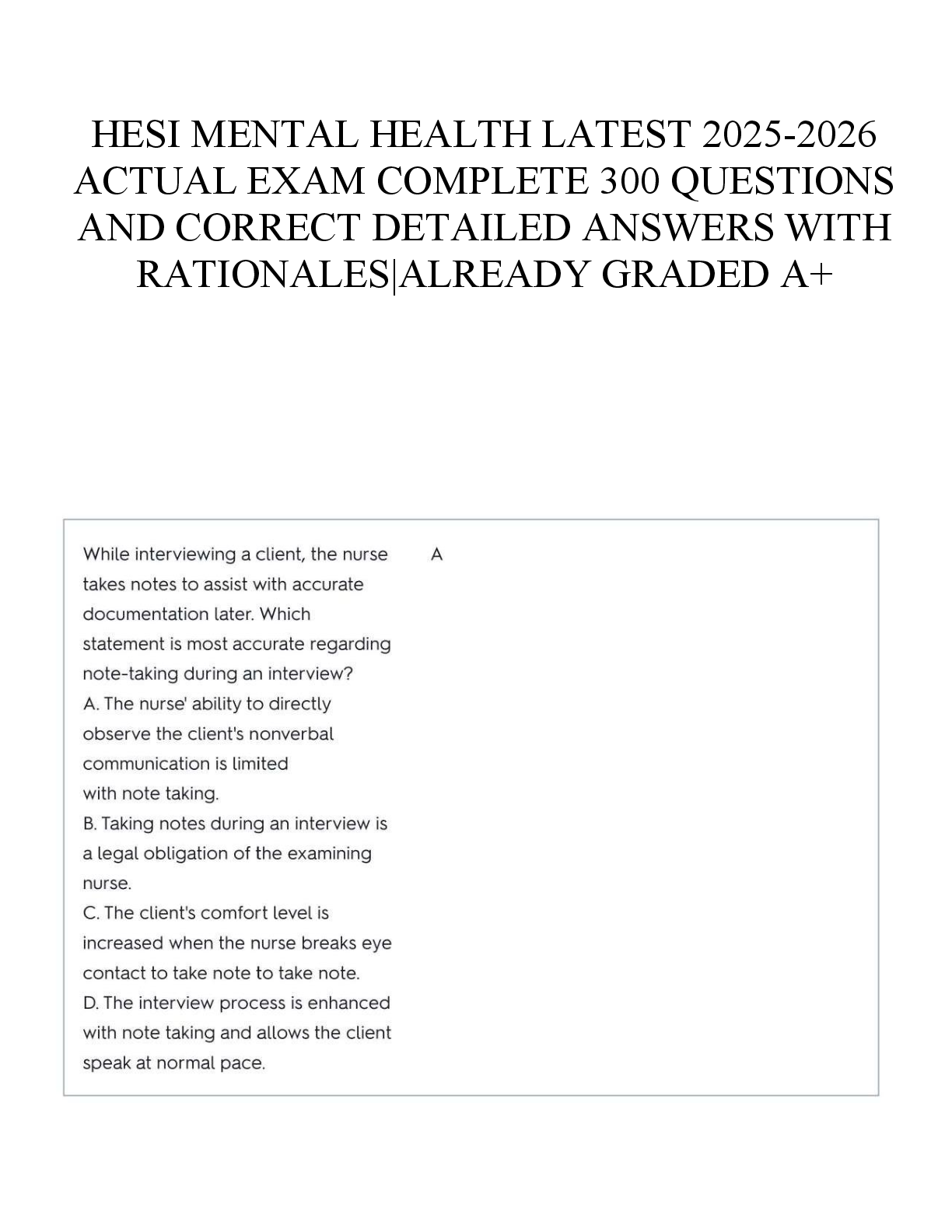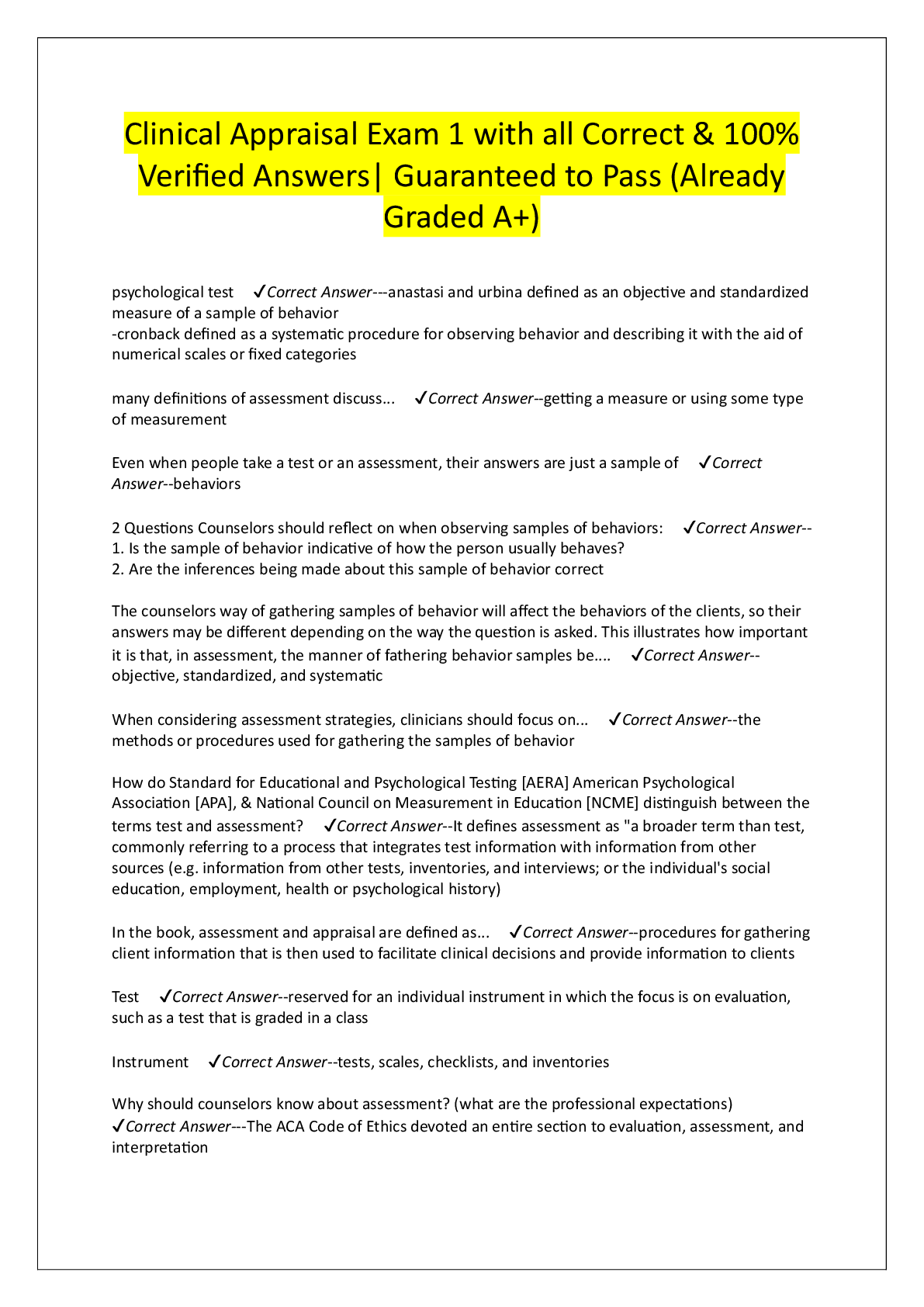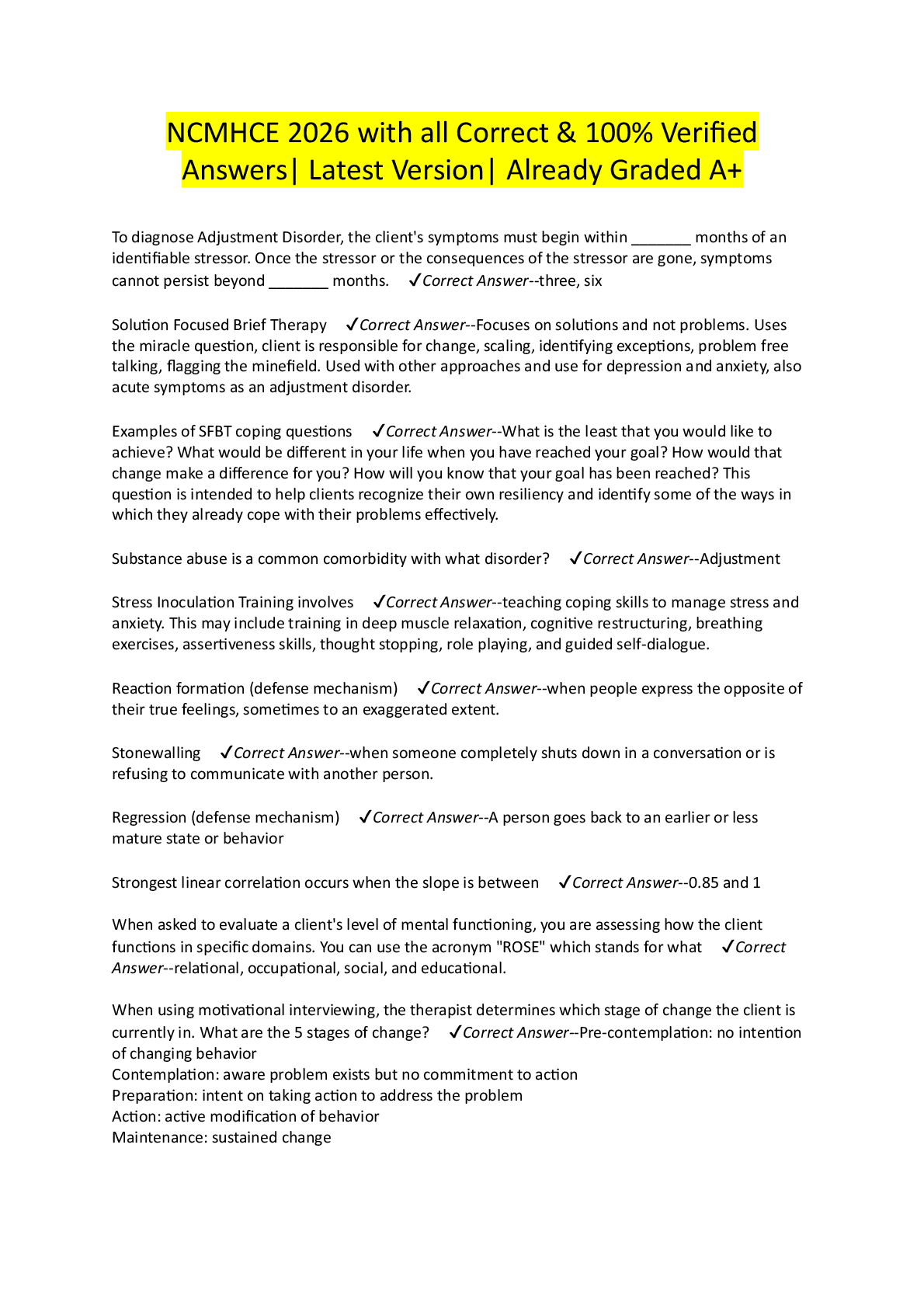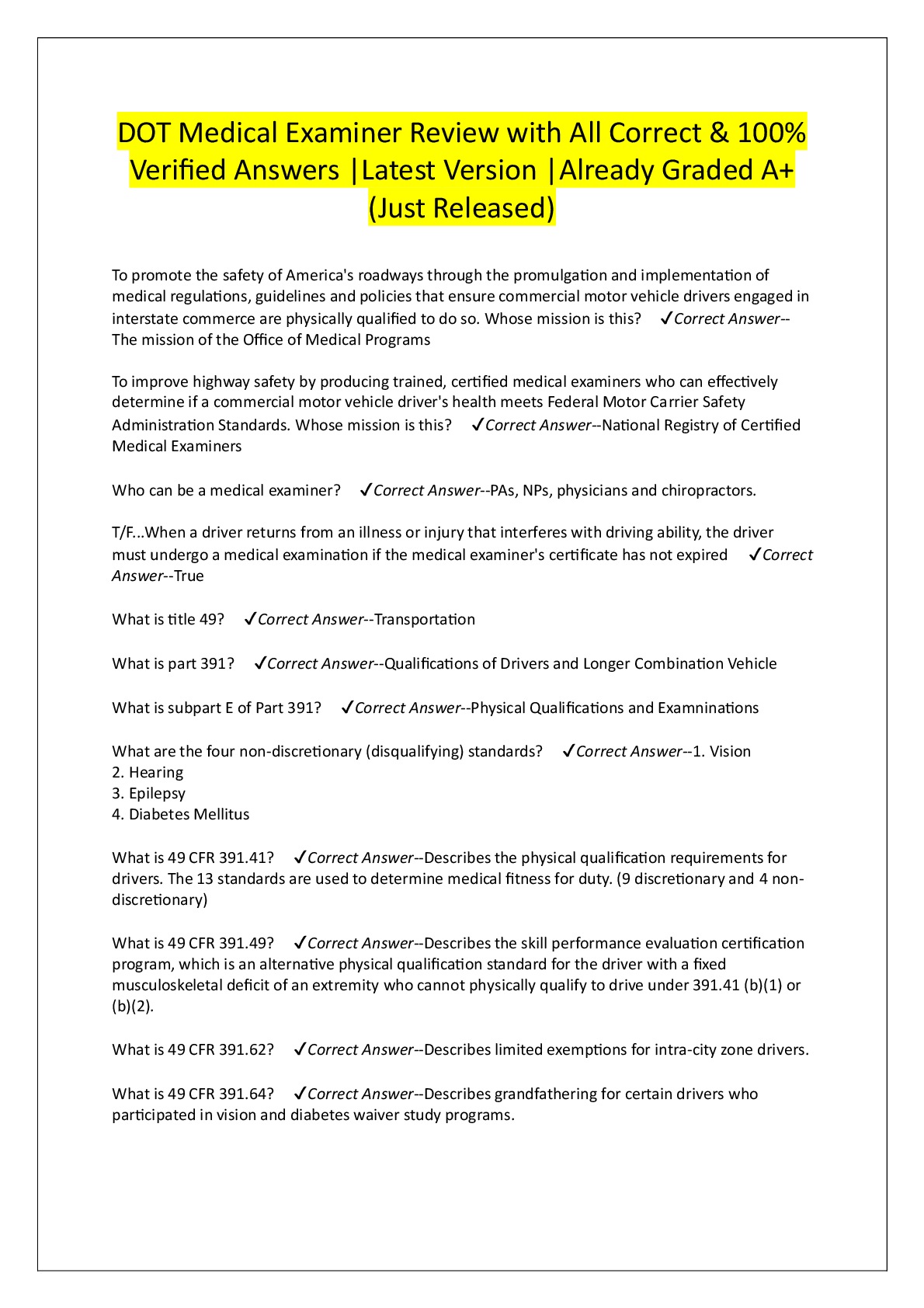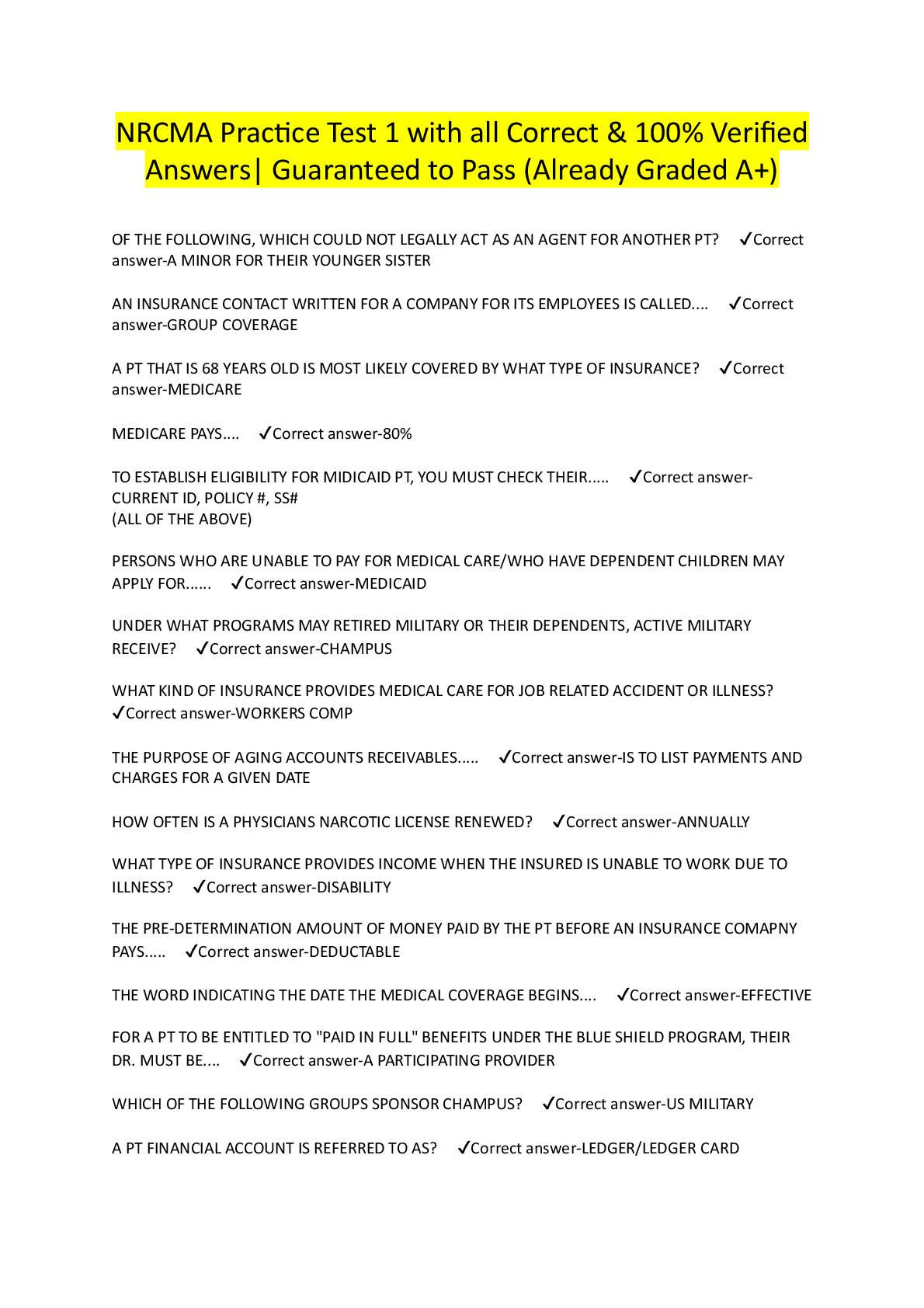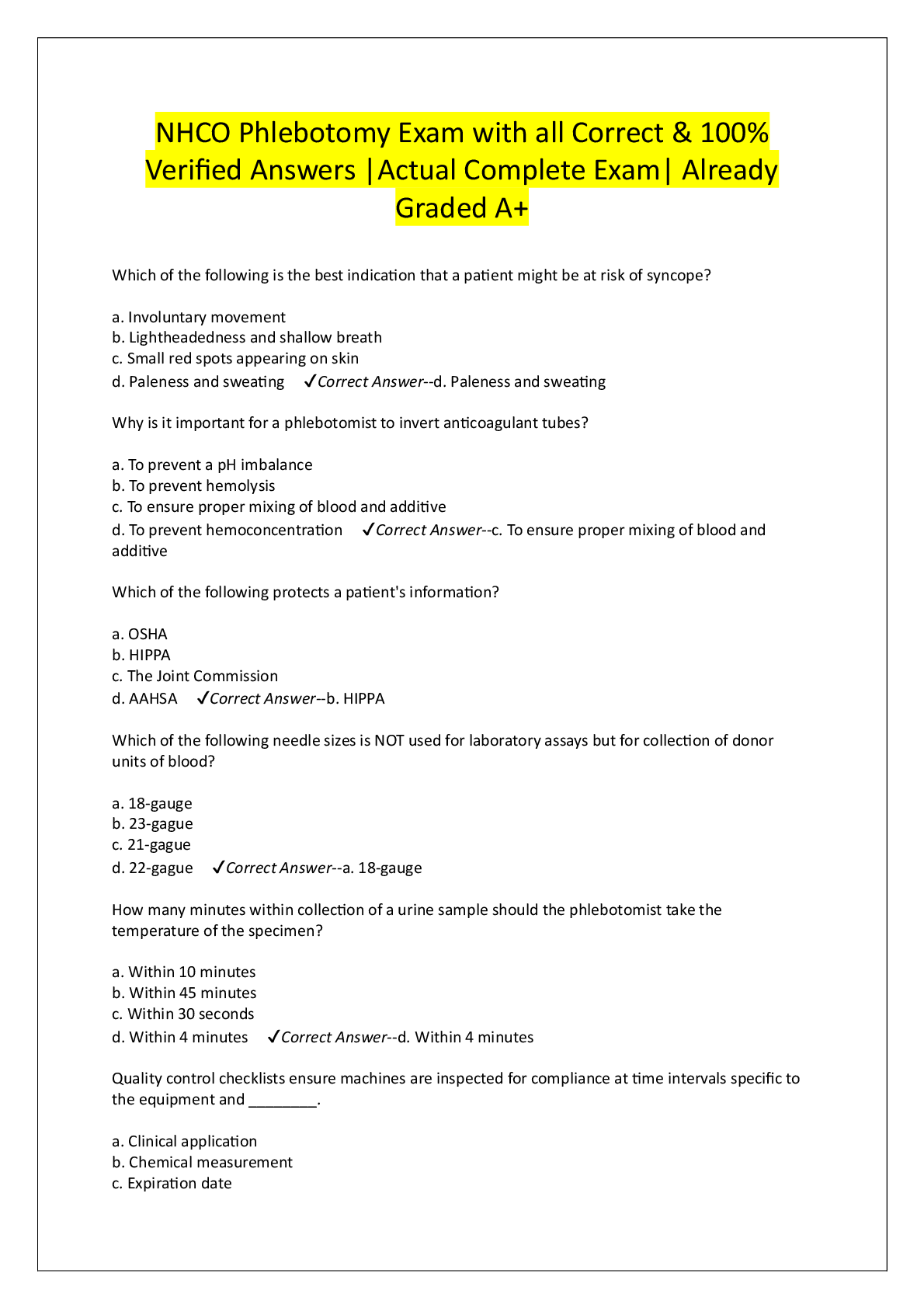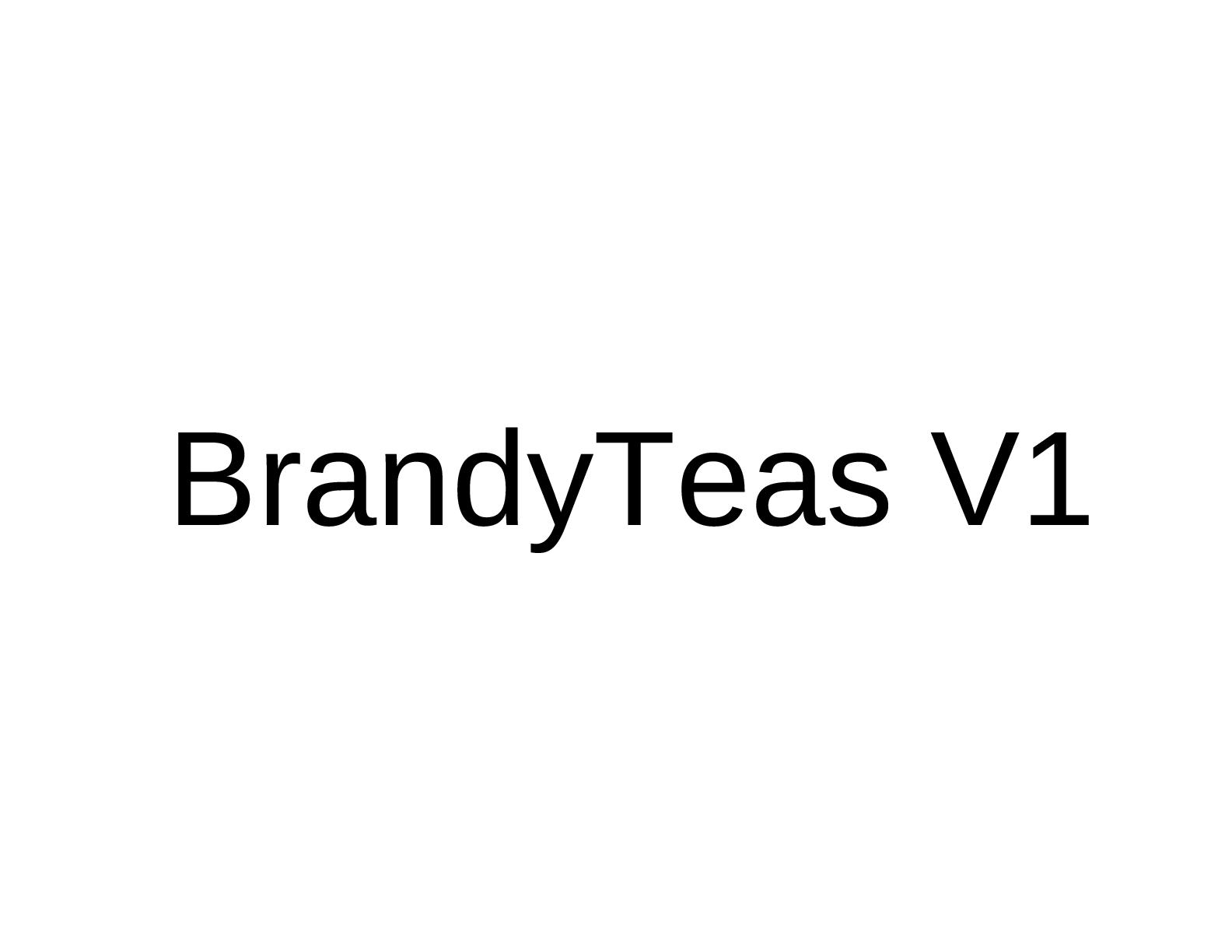CFA 1 Exam 41 Questions with Answers,100% CORRECT
Document Content and Description Below
CFA 1 Exam 41 Questions with Answers In situations where the laws of a member or candidate's country of residence, the local laws of regions where the member or candidate does business, and the ... Code and Standards specify different requirements, the member or candidate must abide by: A. local law or the Code and Standards, whichever is stricter. B. the Code and Standards or his country's laws, whichever are stricter. C. the strictest of local law, his country's laws, or the Code and Standards - CORRECT ANSWER C To comply with Standard I(A) Knowledge of the Law, a member must always abide by the strictest applicable law, regulation, or standard. According to the Standard on independence and objectivity, members and candidates: A. may accept gifts or bonuses from clients. B. may not accept compensation from an issuer of securities in return for producing research on those securities. C. should consider credit ratings issued by recognized agencies to be objective measures of credit quality. - CORRECT ANSWER A Gifts from clients are acceptable under Standard I(B) Independence and Objectivity, but the Standard requires members and candidates to disclose such gifts to their employers. Standard I(B) allows issuerpaid research as long as the analysis is thorough, independent, unbiased, and has a reasonable and adequate basis for its conclwions, and the compensation from the issuer is disclosed. Members and candidates should consider the potential for conflicts of interest inherent in credit ratings and may need to do independent research to evaluate the soundness of these ratings. Bill Cooper finds a table of historical bond yields on the website of the U.S. Treasury that supports the work he has done in his analysis and includes the table as part of his report without citing the source. Has Cooper violated the Code and Standards? A. Yes, because he did not cite the source of the table. B. Yes, because he did not verify the accuracy of the information. C. No, because the table is from a recognized source of financial or statistical data. - CORRECT ANSWER C According to Standard I(C) Misrepresentation, members and candidates must cite the sources of the information they we in their analysis, unless the information is factual data (as opposed to analysis or opinion) from a recognized financial or statistical reporting service. The U.S. Treasury is one example of a recognized source of factual data. Which of the following statements about the Standard on misconduct is most accurate? s. A. Misconduct applies only to a member or candidate's professional activities. B. Neglecting to perform due diligence when required is an example of misconduct. C. A member or candidate commits misconduct by engaging in any illegal activity. - CORRECT ANSWER B Failing to act when required by one's professional obligations, such as neglecting to perform due diligence related to an investment recommendation, violates Standard I(D) Misconduct. Acts a member commits outside his professional capacity are misconduct if they reflect poorly on the member or candidate's honesty, integrity, or competence (e.g., theft or fraud).Violations of the law that do not reflect on the member or candidate's honesty, integrity, or competence (e.g., an act related to civil disobedience) are not necessarily regarded as misconduct. Ed Ingus, CFA, visits the headquarters and main plant of Bullitt Company and observes that inventories of unsold goods appear unusually large. From the CFO, he learns that a recent increase in returned items may result in earnings for the current quarter that are below analysts' estimates. Based on his visit, Ingus changes his recommendation on Bullitt to "Sell." Has Ingus violated the Standard concerning material nonpublic information? A. Yes. B. No, because the information he used is not material. C. No, because his actions are consistent with the mosaic theory. - CORRECT ANSWER A The statement from the CFO about the current quarter's earnings is material nonpublic information. Ingw violated Standard II(A) Material Nonpublic Information by acting or causing others to act on it. Green Brothers, an emerging market fund manager, has two of its subsidiaries simultaneously buy and sell emerging market stocks. In its marketing literature, Green Brothers cites the overall emerging market volume as evidence of the market's liquidity. As a result of its actions, more investors participate in the emerging markets fund. Green Brothers most likely: A. did not violate the Code and Standards. B. violated the Standard regarding market manipulation. C. violated the Standard regarding performance presentation. - CORRECT ANSWER B The intent of Green Brothers' actions is to manipulate the appearance of market liquidity in order to attract investment to its own funds. The increased trading activity was not based on market fundamentals or an actual trading strategy to benefit investors. It was merely an attempt to mislead market participants in order to increase assets under Green Brothers' management. The action violates Standard II(B) Market Manipulation. Cobb, Inc., has hired Jude Kasten, CFA, to manage its pension fund. The client(s) to whom Kasten owes a duty of loyalty are: A. Cobb's management. B. the shareholders of Cobb, Inc. C. the beneficiaries of the pension fund. - CORRECT ANSWER C Standard III(A) Loyalty, Prudence, and Care specifies that for the manager of a pension or trust, the duty ofloyalty is owed to the beneficiaries, not to the individuals who hired the manager. Which of the following actions is most likely a violation of the Standard on fair dealing? A. A portfolio manager allocates IPO shares to all client accounts, including her brother's fee-based retirement account. B. An investment firm routinely begins trading for its own account immediately after announcing recommendation changes to clients. C. After releasing a general recommendation to all clients, an analyst calls the firm's largest institutional clients to discuss the recommendation in more detail. - CORRECT ANSWER B The firm must give its clients an opponunity to act on recommendation changes. Firms can offer different levels of service to clients as long as this is disclosed to all clients. The largest institutional clients would likely be paying higher fees for a greater level of service. The ponfolio manager's brother's account should be treated the same as any other client account. The Standard regarding suitability most likely requires that: A. an advisor must analyze an investment's suitability for the client prior to recommending or acting on the investment. B. a member or candidate must decline to carry out an unsolicited transaction that she believes is unsuitable for the client. C. when managing a fund to an index, a manager who is evaluating potential investments must consider their suitability for the fund's shareholders. - CORRECT ANSWER A According to Standard III(C) Suitability, a member or candidate who is in an advisory relationship with a client is responsible for analyzing the suitability of an investment for the client before taking investment action or making a recommendation. A member or candidate who believes an unsolicited trade is unsuitable for the client can either decline to carry it out or ask the client to provide a statement that suitability is not a consideration for this trade. When managing a fund to an index or stated mandate, the manager is responsible for ensuring that potential investments are consistent with the fund's mandate. Suitability for individuals would be a concern for an advisor who recommends the fund to clients, but not for the manager of the fund. Which of the following is most likely a recommended procedure for complying with the Standard on performance presentation? A. Exclude terminated accounts from past performance history. B. Present the performance of a representative account to show how a composite has performed. C. Consider the level of financial knowledge of the audience to whom the performance is presented. - CORRECT ANSWER C Recommendations stated in Standard III(D) Performance Presentation include considering the sophistication and knowledge of the audience when presenting performance data. Other recommendations are to include terminated accounts in past performance history; to present the performance of a composite as a weighted average of the performance of similar portfolios, rather than using a single representative account; and to maintain the records and data that were used to calculate performance. The CFA Institute Professional Conduct Program (PCP) has begun an investigation into Chris Jones, a Level II CFA candidate, and a number of his CFA Charterholder colleagues. Jones has access to confidential client records that could be useful in clearing his name and wishes to share this information with the PCP. Which of the following most accurately describes Jones's duties with regard to preservation of confidentiality? A. Sharing the confidential information with the PCP would violate the Standards. B. The Standards encourage, but do not require, that Jones support the PCP investigation into his colleagues. C. Jones may share confidential information about former clients with the PCP but may not share confidential information about current clients. - CORRECT ANSWER B Members and candidates are required to cooperate with PCP investigations into their own conduct and encouraged to cooperate with PCP investigations into the conduct of others. Sharing confidential information with the PCP is not a violation of Standard III(E) Preservation of Confidentiality. Any client information shared with the PCP will be kept in strict confidence. Standard III(E) states that members and candidates are required to maintain confidentiality of client records even after the end of the client relationship. Connie Fletcher, CFA, works for a small money management firm that specializes in pension accounts. Recently, a friend asked her to act as an unpaid volunteer manager for the city's street sweep pension fund. As part of the position, the city would grant Fletcher a free parking space in front of her downtown office. Before Fletcher accepts, she should most appropriately: A. do nothing because this is a volunteer position. B. inform her current clients in writing and discuss the offer with her employer. C. disclose the details of the volunteer position to her employer and obtain written permission from her employer. - CORRECT ANSWER C According to Standard IV(A) Loyalty, members and candidates are expected to act for the benefit of their employer and not deprive the employer of their skills. Fletcher is performing work similar to the services that her employer provides. Although the position is a volunteer position, Fletcher will receive compensation in the form of a free parking space. In light of the circumstances, Fletcher must disclose the details of the position to her employer and get written permission before accepting the volunteer position. Sarah Johnson, a portfolio manager, is offered a bonus directly by a client if Johnson meets certain performance goals. To comply with the Standard that governs additional compensation arrangements, Johnson should: A. decline to accept a bonus outside of her compensation from her employer. B. disclose this arrangement to her employer in writing and obtain her employer's permission. C. disclose this arrangement to her employer only if she actually meets the performance goals and receives the bonus. - CORRECT ANSWER B Johnson should disclose her additional compensation arrangement in writing to her employer and obtain her employer's written consent before accepting this offer, in accordance with Standard IV(B) Additional Compensation Arrangements. A member or candidate who has supervisory responsibility: A. should place particular emphasis on enforcing investment-related compliance policies. B. is responsible for instructing those to whom he has delegated authority about methods to detect and prevent violations of the law and the Code and Standards. C. has complied with the Standards if she reports employee violations to upper management and provides a written warning to the employee to cease such activities. - CORRECT ANSWER B Members or candidates may delegate supervisory duties to subordinates but remain responsible for instructing them about how to detect and prevent violations. Reporting the violation and warning the employee are not sufficient to comply with Standard IV(C) Responsibilities of Supervisors. The supervisor must also take steps to prevent further violations while she conducts an investigation, such as limiting the employee's activity or increasing her monitoring of the employee. Supervisors should enforce investment-related and non-investment related policies equally. Which of the following actions is a required, rather than recommended, action under the Standard regarding diligence and a reasonable basis for a firm's research recommendations? A. Compensate analysts based on a measure of the quality of their research. B. Review the assumptions used and evaluate the objectivity of third-party research reports. C. Have a policy requiring that research reports and recommendations have a basis that can be substantiated as reasonable and adequate. - CORRECT ANSWER B Standard V(A) Diligence and Reasonable Basis requires analysts who use third-party research to review its assumptions and evaluate the independence and objectivity of the research. The other choices are recommended procedures for compliance with the Standard Claire Marlin, CFA, manages an investment fund specializing in foreign currency trading. Marlin writes a report to investors that describes the basic characteristics of her strategy, which is based on an expected appreciation of the euro relative to other major currencies. Marlin shows the projected returns from the strategy if the euro appreciates less than 5o/o, between 5o/o and 1 Oo/o, or more than 10o/o, while dearly stating that these forecasts are her opinion. Has Marlin violated the Standard related to communication with clients? A. Yes. B. No, because she disclosed the basic characteristics of the investment. C. No, because she distinguished fact from opinion and discussed how the strategy may perform under a range of scenarios. - CORRECT ANSWER A Standard V(B) Communication with Clients and Prospective Clients requires that members and candidates communicate the risk associated with the investment strategy used and how the strategy is expected to perform in a range of scenarios. These scenarios should include those different from the current trend. Marlin should have discussed how her strategy would perform if the euro depreciates instead of appreciating as she expects. If regulations do not specify how long to retain the documents that support an analyst's conclusions, the Code and Standards recommend a period of at least: A. five years. B. seven years. C. ten years. - CORRECT ANSWER B When no other regulatory guidance applies, Standard V(C) Record Retention recommends that records be maintained for a minimum of seven years. Daniel Lyons, CFA, is an analyst who covers several stocks including Horizon Company. Lyons's aunt owns 30,000 shares of Horizon. She informs Lyons that she has created a trust in his name into which she has placed 2,000 shares of Horizon. The trust is structured so that Lyons will not be able to sell the shares until his aunt dies, but may vote the shares. Lyons is due to update his research coverage of Horizon next week. Lyons should most appropriately: A. update the report as usual because he is not a beneficial owner of the stock. B. advise his superiors that he is no longer able to issue research recommendations on Horizon. C. disclose the situation to his employer and, if then asked to prepare a report, also disclose his beneficial ownership of the shares in his report. - CORRECT ANSWER C Even though the shares are held in trust, Lyons is considered a beneficial owner under Standard VI(A) Disclosure of Conflicts because he has a pecuniary interest in the shares and because has the power to vote the shares. Lyons is obligated to inform his employer of the potential conflict. If Lyons's employer permits him to continue issuing investment recommendations on the company, Lyons must disclose the existence of a potential conflict in his reports. Kate Wilson, CFA, is an equity analyst. Wilson enters two transactions for her personal account. Wilson sells 500 shares ofTibon, Inc., a stock on which her firm currently has a "Buy" recommendation. Wilson buys 200 shares of Hayfield Co. and the following day issues a research report on Hayfield with a "Buy" recommendation. Has Wilson violated the Code and Standards? A. No. B. Yes, both of her actions violate the Code and Standards. C. Yes, but only one of her actions violates the Code and Standards. - CORRECT ANSWER C Only one of these transactions is a violation. Standard VI(B) Priority of Transactions requires members and candidates to give clients an adequate opportunity to act on a recommendation before trading for accounts in which the member or candidate has a beneficial ownership interest. Members and candidates may trade for their own accounts as long as they do not disadvantage clients, benefit personally from client trades, or violate any regulations that apply. The Standard does not prohibit members and candidates from entering personal transactions that are contrary to what their firms are recommending for clients, as long as the transaction does not violate any of these criteria. Hern Investments provides monthly emerging market research to Baker Brokerage in exchange for prospective client referrals and European equity research from Baker. Clients and prospects of Hern are not made aware of the agreement, but clients unanimously rave about the high quality of the research provided by Baker. As a result of the research, many clients with nondiscretionary accounts have earned substantial returns on their portfolios. Managers at Hern have also used the research to earn outstanding returns for the firm's discretionary accounts. Hern has most likely: A. not violated the Code and Standards. B. violated the Code and Standards by using third-party research in discretionary accounts. C. violated the Code and Standards by failing to disclose the referral agreement with Baker. - CORRECT ANSWER C According to Standard VI( C) Referral Fees, Hern must disclose the referral arrangement between itself and Baker so that potential clients can judge the true cost of Hern's services and assess whether there is any partiality inherent in the recommendation of services. After writing the CFA Level I exam, Cynthia White goes to internet discussion site CPA Havm to express her frustration. White writes, "CFA Institute is not doing a competent job of evaluating candidates because none of the questions in the June exam touched on Alternative Investments." White most likely violated the Standard related to conduct as a candidate in the CFA program by: A. publicly disputing CFA Institute policies and procedures. B. disclosing subject matter covered or not covered on a CFA exam. C. participating in an internet forum that is directed toward CFA Program participants. - CORRECT ANSWER B Standard VII(A) Conduct as Members and Candidates in the CFA Program prohibits candidates from revealing which portions of the Candidate Body of Knowledge were or were not covered on an exam. Members and candidates are free to disagree with the policies, procedures, or positions taken by the CFA Institute. The Standard does not prohibit participating in CFA Program-related internet blogs, forums, or social networks. After passing all three levels of the CFA exams on her first attempts and being awarded her CFA Charter, Paula Osgood is promoting her new money management firm by issuing an advertisement. Which of these statements would most likely violate the Standard related to use of the CFA designation? A. "To earn the right to use the CFA designation, Paula passed three exams covering ethics, financial statement analysis, asset valuation, and portfolio management." B. "Paula passed three 6-hour exams on her first attempts and is a member of her local investment analyst society." C. "Because of her extensive training, Paula will be able to achieve better investment results than managers who have not been awarded the CFA designation." - CORRECT ANSWER C Standard VII(B) Reference to CFA Institute, the CFA Designation, and the CFA Program prohibits members and candidates from implying superior performance as a result of being a CFA charterholder. Concise factual descriptions of the requirements to obtain the CFA Charter are acceptable. Osgood's statement that she passed the exams on her first attempts is acceptable because it states a fact. Which of the following statements most accurately describes the parties that GIPS are intended to apply to and serve? GIPS apply to: A. consultants who serve their existing and prospective clients. B. firms that issue securities and serve investment management firms. C. investment management firms and serve their existing and prospective clients. - CORRECT ANSWER C GIPS apply to investment management firms. They are intended to serve prospective and existing clients of investment firms and consultants who advise these clients. For a composite to be constructed in compliance with GIPS, the portfolios included in the composite must: A. have been managed by the firm for the full performance reporting period. B. be selected immediately after the last business day of the period for which the composite's performance will be presented. C. include all fee-paying, discretionary portfolios that are managed according to the same strategy, mandate, or investment objective. - CORRECT ANSWER C To comply with GIPS, a composite must include all fee-paying, discretionary portfolios managed according to the same investment objective, strategy, or mandate. The composite or composites in which a portfolio will be included must be determined on an ex-ante basis (i.e., before the period for which the composite's performance will be calculated). A GIPS-compliant composite must include terminated accounts. Verification of compliance with GIPS: A. may be performed on single composites. B. is required for a firm to claim GIPS compliance. C. requires the verification report to be issued for the entire firm. - CORRECT ANSWER C Verification of GIPS compliance is optional, but if a firm chooses to seek third-party verification, the repon must be issued with respect to the whole firm. GIPS verification cannot be carried out for a single composite. Firms that claim to present investment performance in compliance with GIPS are required to: A. document the procedures and policies they use to ensure GIPS compliance. B. clearly disclose any calculations or other aspects of a presentation that are non-compliant with GIPS. C. calculate total firm assets as the fair value of all fee-paying discretionary portfolios managed by the firm. - CORRECT ANSWER A GIPS Section 0, "Fundamentals of Compliance," states that firms must document their procedures for remaining in compliance with GIPS. Firms which state that they are in compliance with GIPS must comply fully and may not claim partial compliance. GIPS defines total firm assets as the fair value of all portfolios managed by the firm, including discretionary and non-discretionary, fee-paying and non-fee-paying portfolios. Which of the following definitions of a firm would violate GIPS? A. Investment firm that has been in existence for less than five years. B. Regional branch of an investment management firm marketed under the name of its parent. C. Entity registered with the national regulator that oversees its investment management activities. - CORRECT ANSWER B The definition of a firm for GIPS-compliant performance presentation should include all geographical offices marketed under the same name brand. If a country has regulations in place that conflict with GIPS, firms that wish to claim GIPS compliance: A. may not do so because GIPS do not permit exceptions or partial compliance. B. must establish a subsidiary in a location where local law does not conflict with GIPS. C. must comply with local regulations and disclose the nature of the conflict in the presentation. - CORRECT ANSWER C Firms must always comply with the laws and regulations of the country in which they reside. In cases where local regulations conflict with GIPS, a firm can still claim GIPS compliance if they disclose the conflict fully in an otherwise compliant presentation. Which of the following includes only sections of the: Global Investment Performance Standards? A. Disclosure, Public Equity, Presentation and Reporting. B. Real Estate, Calculation Methodology, Fundamentals of Compliance. C. Input Data, Composite Construction, Wrap Fee/Speculative Margin Account (SMA) Portfolios. - CORRECT ANSWER B The nine major sections of GIPS are (0) Fundamentals of Compliance; (1) Input Data; (2) Calculation Methodology; (3) Composite Construction; (4) Disclosure; (5) Presentation and Reporting; (6) Real Estate; (7) Private Equity; and (8) Wrap Fee/ Separately Managed Account (SMA) Portfolios. An analyst is evaluating the degree of competition in an industry and compiles the following information: • Few significant barriers to entry or exit exist. • Firms in the industry produce slightly differentiated products. • Each firm faces a demand curve that is largely unaffected by the actions of other individual firms in the industry. The analyst should characterize the competitive structure of this industry as: A. oligopoly. B. monopoly. C. monopolistic competition - CORRECT ANSWER C Both oligopoly and monopolistic competition are consistent with firms that produce slightly differentiated products. However, with few significant barriers to entry and little interdependence among competitors, the industry does not fit the definition of an oligopoly and would be best characterized as monopolistic competition. Which of the following statements about the behavior of firms in a perfectly competitive market is least accurate? A. A firm experiencing economic losses in the short run will continue to operate if its revenues are greater than its variable costs. B. A firm that is producing less than the quantity for which marginal cost equals the market price would lose money by increasing production. C. If firms are earning economic profits in the short run, new firms will enter the market and reduce economic profits to zero in the long run. - CORRECT ANSWER B A firm that is producing more than the quantity where its marginal revenue (the market price in perfect competition) is equal to its marginal cost is losing money on sales of additional units. A firm producing where marginal cost is less than price is foregoing additional profit by not increasing production. The other responses accurately describe characteristics of firms in perfectly competitive markets. Compared to a customs union or a common market, the primary advantage of an economic union is that: A. its members adopt a common currency. B. its members have a common economic policy. C. it removes barriers to imports and exports among its members. - CORRECT ANSWER B The advantage of an economic union is that its members establish common economic policies and institutions. A common currency is a characteristic of a monetary union. All regional trading agreements remove barriers to imports and exports among their members. Which of the following statements about consumer surplus and producer surplus is most accurate? A. Economic gains to society are maximized at the price and quantity where consumer surplus and producer surplus are equal. B . No producer surplus is realized o n the sale o f an additional unit o f a good if the opportunity cost of producing it is greater than the price received. C. A consumer is not willing to buy an additional unit of a good if his consumer surplus from the next unit is less than his consumer surplus from the previous unit. - CORRECT ANSWER B Producers realize a producer surplus on the next unit of a good when the price they receive for it is greater than the opportunity cost of producing it. Economic gains to society are greatest when the sum of consumer surplus and producer surplus is maximized, regardless of which is larger. A consumer is willing to buy an additional unit of a good as long as it will generate any additional consumer surplus. Other things equal, an increase of 2 .0o/o in the price of Product X results in a 1 .4% increase in the quantity demanded of Product Y and a 0. 7% decrease in the quantity demanded of Product Z. Which statement about products X, Y and Z is least accurate? A. Products X and Y are substitutes. B . Products X and Z are complements. C. Products Y and Z are complements. - CORRECT ANSWER C It does not necessarily follow from the information given in the question that products Y and Z are complements. The increase in the price of Product X caused the quantity demanded of Product Y to increase (positive cross price elasticity) and caused the quantity demanded of Product Z to decrease (negative cross price elasticity). This suggests that Product Y is a substitute for Product X, and Product Z is a complement to Product X. But this does not mean Product Y is a complement to Product Z. For example, gasoline is a complement to automobiles; bicycles are a substitute for automobiles; but gasoline is not a complement to bicycles. The EUR/USD spot exchange rate is 0.701 45, and 1 -year interest rates are 3o/o in EUR and 2o/o in USD. The forward USD/EUR exchange rate is closest to: A. 1 . 1 426. B. 1 .4 1 1 8 . c. 1 .4396. - CORRECT ANSWER B 0.70145 x 1.03 /1.02= 0.7083; 1 / 0.7083= 1.4118 Depreciation of a country's currency is most likely to narrow its trade deficit when: A. its imports are greater in value than its exports. B. price elasticity of import demand is greater than one. C. investment increases relative to private and government savings. - CORRECT ANSWER B The elasticity's approach to evaluating the effect of exchange rates on the trade balance suggests that the more elastic both import demand and export demand are, the more likely currency depreciation is to narrow a trade deficit. A country with a trade deficit imports more than its exports by definition. An increase in investment relative to savings would tend to increase the trade deficit (net exports equal private and government savings minus investment). According to real business cycle theory, business cycles result from: A. rational responses to external shocks. B. inappropriate changes in monetary policy. C. increases and decreases in business confidence. - CORRECT ANSWER A Real business cycle theory holds that economic cycles are driven by utility-maximizing individuals and firms responding to changes in real economic factors, such as changes in technology. Keynesian cycle theory attributes the business cycle to changes in business confidence. Monetarist theory attributes the business cycle to inappropriate changes in the rate of money supply growth. A decrease in the target U.S. federal funds rate is least likely to result in: A. a proportionate decrease in long-term interest rates. B. an increase in consumer spending on durable goods. C. depreciation of the U.S. dollar on the foreign exchange market. - CORRECT ANSWER A Changes in the U.S. federal funds rate and changes in long-term interest rates are unlikely to be proportionate. Long-term rates are the sum of short-term rates and a premium for the expected rate of inflation. If a decrease (increase) in the target federal funds rate by the Fed causes economic agents to increase (decrease) their inflation expectations, the change in long-term rates will be less than the change in the federal funds rate. Increases in spending on consumer durables and a decrease in the foreign exchange value of the U.S. dollar are among the expected results of a decrease in the target U.S. federal funds rate. For an economy that i s initially at full-employment real G D P, a n increase in aggregate demand will most likely have what effects on the price level and real GDP in the short run? A . Both will increase in the short run. B. Neither will increase in the short run. C. Only one will increase in the short run. - CORRECT ANSWER A An increase in aggregate demand will cause short-run equilibrium to move along the short-run aggregate supply curve (SAS). This will tend to increase both real GOP and the price level in the short run. Potential real GDP is least likely to increase as a result of an: A. improvement in technology. B. increase in the money wage rate. C. increase in the labor force participation ratio. - CORRECT ANSWER B An increase in the money wage rate would not increase long-run aggregate supply (potential real GOP), but instead would decrease the short-run aggregate supply curve. An improvement in technology would tend to increase potential real GOP. An increase in the participation ratio increases the full-employment quantity of labor supplied and potential real GOP. When the economy is operating at the natural rate of unemployment, it is most likely that: A. inflation is accelerating. B. frictional unemployment is absent. C. structural unemployment is present. - CORRECT ANSWER C Structural and frictional unemployment are always present. The natural rate of unemployment is the lowest rate consistent with non-accelerating inflation. [Show More]
Last updated: 2 years ago
Preview 1 out of 19 pages
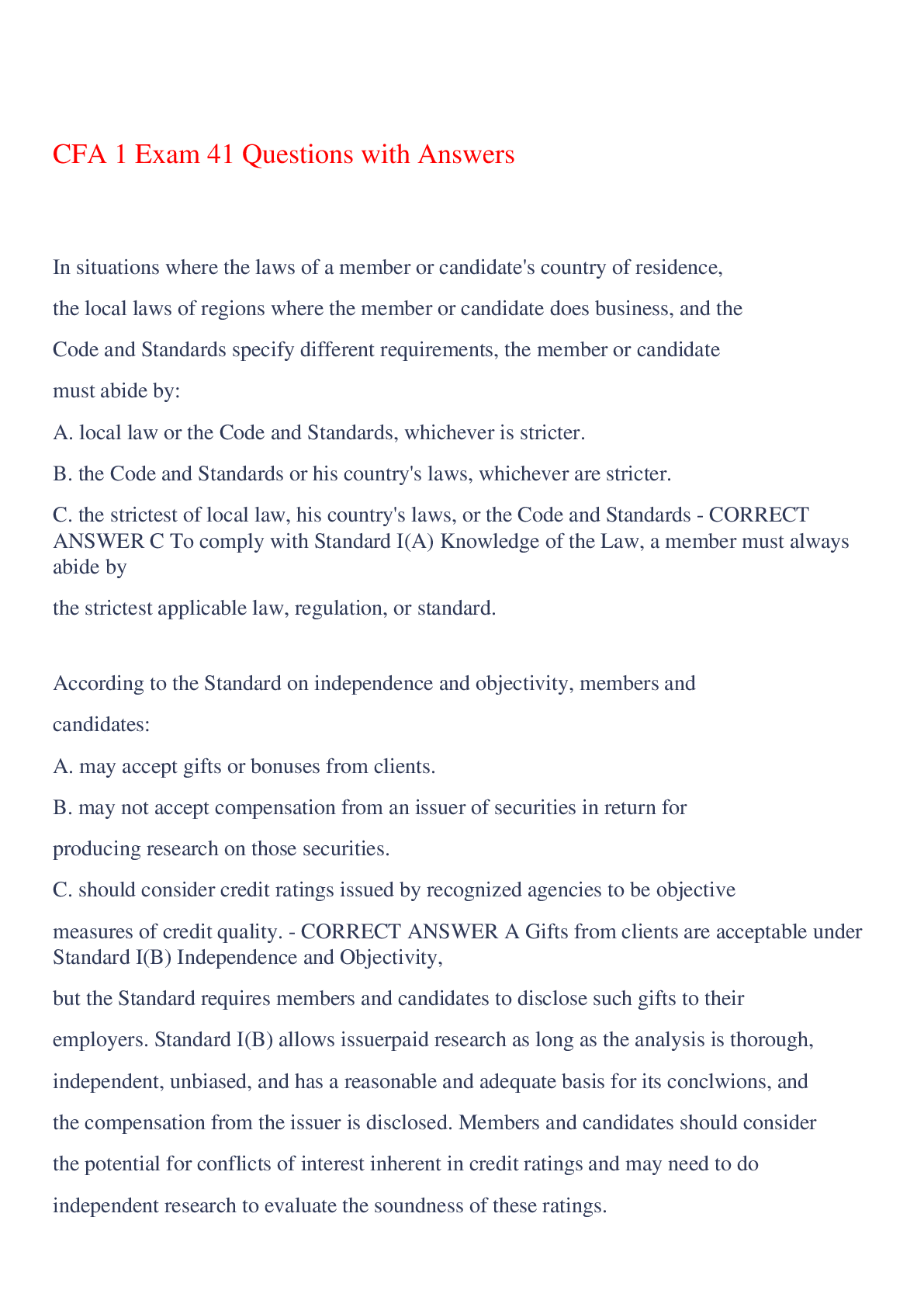
Buy this document to get the full access instantly
Instant Download Access after purchase
Buy NowInstant download
We Accept:

Also available in bundle (1)
Click Below to Access Bundle(s)

CFA LEVEL 1 Exam (18 SETS) Questions with Verified Answer 2023,100% CORRECT
CFA LEVEL 1 Exam 275 Questions with Verified Answer 2023, CFA Level 1 - 101 Must Knows 368 Questions with Verified Answers,CFA level 1 Exam 48 Questions with Verified Answers,CFA Level 1 FRA Exam 96...
By Nolan19 2 years ago
$35.5
18
Reviews( 0 )
$8.00
Can't find what you want? Try our AI powered Search
Document information
Connected school, study & course
About the document
Uploaded On
Jun 18, 2023
Number of pages
19
Written in
All
Additional information
This document has been written for:
Uploaded
Jun 18, 2023
Downloads
0
Views
251


